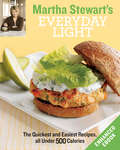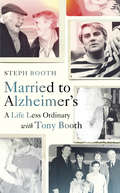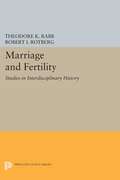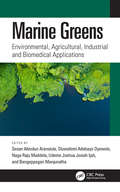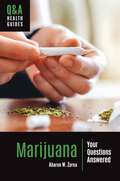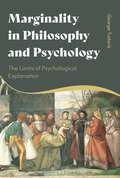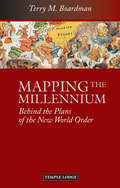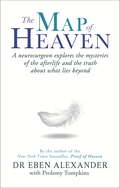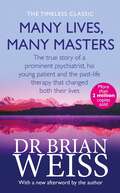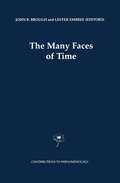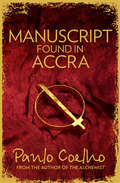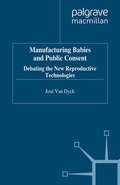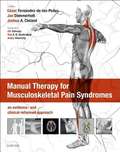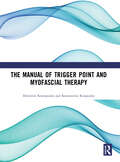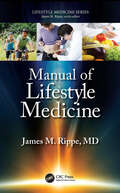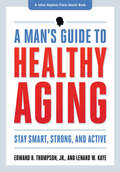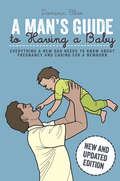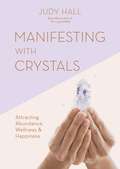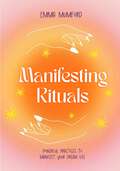- Table View
- List View
Martha Stewart's Everyday Light (Enhanced Edition)
by Martha StewartThis enhanced edition includes hundreds of colour photographs and 13 instructional step-by-step videos that demonstrate stir-frying, cooking in parchment, pan-searing fish, and more!From the Queen of American cookery comes a fabulous collection of recipes - all 500 calories or less, and all big on flavour!Martha Stewart knows it's not enough for home cooks to prepare tasty weeknight meals in a flash - they also need to be healthy and appealing for the whole family. Martha Stewart's Everyday Light features delicious, low-fat recipes that are made with accessible ingredients, and each recipe is accompanied by beautiful colour photography to keep you inspired and cooking light every day of the week. The recipes, which are organised seasonally, include salads, soups, stews, main courses, easy sides, desserts, and more. You'll find slimmed-down favourites, such as Beef Chilli, Chicken Parmesan, and deceptively skinny Chocolate-Chunk Brownies, plus new delights such as Spicy Chicken Stir-Fry with Peanuts and Salmon Burgers with Yoghurt-Dill Sauce. With basic low-fat cooking techniques (stir-frying, cooking in parchment, grilling), tips on the 10 best ways to boost flavour without adding fat (including marinades, dressings, herbs and spices), and simple tools for low-calorie cooking (cast-iron skillets and grill pans and steamer baskets), Martha Stewart's Everyday Light helps you cook the kind of delicious, healthy food you really want to eat!
Married to Alzheimer's: A Life Less Ordinary with Tony Booth
by Steph BoothEXTRAORDINARY MEMOIR OF A LIFE AND LOVE TORN APART BY DEMENTIAWhen her husband Tony was diagnosed with Alzheimer’s in 2004, Steph Booth had to say goodbye to life as she knew it. The disease encroached into their lives, taking away Tony day by day. Open and honest, but with heart and warmth, Steph reveals and the hardship of caring for Tony and losing herself in the midst of it. Along the way we learn of the people they were, the dynamics of their relationship – Tony’s theatrics, Steph’s stubbornness – effortlessly captured with lightness and humour. Borne out of her much-loved Irish Times column, Married to Alzheimer’s is a poignant account of a life and love torn apart by dementia and a bond that was unshakeable. Tony was never a conformist. An actor, rebel, raconteur. The frustration, the grief, the laughter, the anger, the joy meant life with him was anything but ordinary.
Marriage and Fertility: Studies in Interdisciplinary History
by Theodore K. Rabb Robert I. RotbergIn this volume the articles are primarily on European history, but their subject matter indicates the remarkable variety, both of the marriage and fertility patterns of past societies, and of the methods scholars have used to investigate them.Originally published in 1981.The Princeton Legacy Library uses the latest print-on-demand technology to again make available previously out-of-print books from the distinguished backlist of Princeton University Press. These editions preserve the original texts of these important books while presenting them in durable paperback and hardcover editions. The goal of the Princeton Legacy Library is to vastly increase access to the rich scholarly heritage found in the thousands of books published by Princeton University Press since its founding in 1905.
Marma Therapy: The Healing Power of Ayurvedic Vital Point Massage
by Stefan Schrott Dr Ernst Schrott Dr J. RajuThe theory and practice of Marma therapy is explained in this book with step-by-step full colour instructions. This Ayurvedic form of gentle massage can help with everything from headaches and back pain, to exam nerves and skin problems.
Marine Greens: Environmental, Agricultural, Industrial and Biomedical Applications
by Sesan Abiodun Aransiola, Oluwafemi Adebayo Oyewole, Naga Raju Maddela, Udeme Joshua Josiah Ijah, and Bangeppagari ManjunathaThis book provides an in-depth overview of marine greens and their environmental and biotechnological applications. It addresses concepts such as the niche adaptation strategies of marine greens in their natural habitats, as well as their global distribution, and factors affecting their distribution and proliferation.Marine greens are posited as an alternative to fossil fuels, mitigating global climate change and thereby fostering future environmental sustainability. In addition, the book explains the remediation of xenobiotics, wastewater, microplastics, marine debris and marine green contamination. Expert authors from around the world explore the industrial and agricultural applications of marine greens in the production of enzymes and marine bioenergy, and what is needed to improve its production potential.This is important reading for government and non-governmental organizations as well as industries and research institutions looking for ways to combat current industrial and environmental challenges.
Marine Greens: Environmental, Agricultural, Industrial and Biomedical Applications
This book provides an in-depth overview of marine greens and their environmental and biotechnological applications. It addresses concepts such as the niche adaptation strategies of marine greens in their natural habitats, as well as their global distribution, and factors affecting their distribution and proliferation.Marine greens are posited as an alternative to fossil fuels, mitigating global climate change and thereby fostering future environmental sustainability. In addition, the book explains the remediation of xenobiotics, wastewater, microplastics, marine debris and marine green contamination. Expert authors from around the world explore the industrial and agricultural applications of marine greens in the production of enzymes and marine bioenergy, and what is needed to improve its production potential.This is important reading for government and non-governmental organizations as well as industries and research institutions looking for ways to combat current industrial and environmental challenges.
Marijuana: Your Questions Answered (Q&A Health Guides)
by Aharon W. ZoreaThis book explores marijuana from a variety of angles, including its impacts on the brain and body, potential for abuse, and legal status. Relying on science rather than sensationalism, it answers young readers' most pressing questions about this controversial drug.In 2022, medical marijuana is legal in 37 states and recreational marijuana is legal in 18, yet the drug remains illegal at the federal level. Public opinion on marijuana has changed substantially in the last 20 years, and today many young people view the drug as benign or even beneficial. But how exactly does marijuana affect the body and mind, and what are the potential risks of abuse or addiction?Books in Greenwood's Q&A Health Guides series follow a reader-friendly question-and-answer format that anticipates readers' needs and concerns. Prevalent myths and misconceptions are identified and dispelled, and a collection of case studies illustrate key concepts and issues through relatable stories and insightful recommendations. Each book also includes a section on health literacy, equipping teens and young adults with practical tools and strategies for finding, evaluating, and using credible sources of health information both on and off the internet—important skills that contribute to a lifetime of healthy decision-making.
Marginality in Philosophy and Psychology: The Limits of Psychological Explanation
by George TudorieDiscussing marginality from an analytic perspective and drawing on canonical theories by a diverse set of authors, such as Dilthey, Collingwood, Wittgenstein, Foucault, John McDowell, Susan Carey, Michael Tomasello, and Chris Frith, this book is an important contribution to ongoing debates on marginality among psychiatrists, psychologists, social scientists, and philosophers.Psychology often resorts to overambitious theorizing due to a perceived pressure to justify its scientific credentials. Taking the cases of preverbal children and mentally ill patients, George Tudorie illustrates that applying overarching and unifying explanations to marginal subjects is problematic, arguing instead that those at the margins should be given their proper explanatory autonomy.Tudorie examines recent cognitive theories on early development in children to reveal the difficulties of conceptualising the emergence of human abilities, while also demonstrating how cognitive accounts of psychosis, built around the typical concepts of 'belief-desire-intention' psychology, eventually falter. In doing so, he reveals that interpretation is not a route psychology can take at the margins, and calls for a clearer view of explanatory options in marginal cases.
Marginality in Philosophy and Psychology: The Limits of Psychological Explanation
by George TudorieDiscussing marginality from an analytic perspective and drawing on canonical theories by a diverse set of authors, such as Dilthey, Collingwood, Wittgenstein, Foucault, John McDowell, Susan Carey, Michael Tomasello, and Chris Frith, this book is an important contribution to ongoing debates on marginality among psychiatrists, psychologists, social scientists, and philosophers.Psychology often resorts to overambitious theorizing due to a perceived pressure to justify its scientific credentials. Taking the cases of preverbal children and mentally ill patients, George Tudorie illustrates that applying overarching and unifying explanations to marginal subjects is problematic, arguing instead that those at the margins should be given their proper explanatory autonomy.Tudorie examines recent cognitive theories on early development in children to reveal the difficulties of conceptualising the emergence of human abilities, while also demonstrating how cognitive accounts of psychosis, built around the typical concepts of 'belief-desire-intention' psychology, eventually falter. In doing so, he reveals that interpretation is not a route psychology can take at the margins, and calls for a clearer view of explanatory options in marginal cases.
Mapping the Millennium: Behind the Plans of the New World Order
by Terry M. BoardmanIn a quest to discover the truth behind the twentieth century’s disastrous record of conflict and war, Terry Boardman considers two contradictory approaches to history: so-called cock-up theory and conspiracy theory. Could there be truth to the often-dismissed concept of conspiracy in history: the manipulation of external events by groups and individuals mostly hidden from the public eye? In the work of philosopher and scientist Rudolf Steiner, Boardman finds convincing evidence of the existence of secretive circles in the West, which have plans for humanity’s long-term future. Steiner indicated that such "brotherhoods" had prepared for world war in the twentieth century, and had instructed their members, using redrawn maps as a guide, on how Europe was to be changed.If these brotherhoods existed in Steiner’s time, could they still be active today? Based on detailed research, Boardman concludes that such groups are directing world politics in our time. As backing for his theory, he studies a series of important articles and maps - ranging from an 1890 edition of the satirical journal Truth to more recent pieces from influential publications that speak for themselves. He concludes that vast plans are in progress for a New World Order to control and direct individuals and nations, and he calls us to be vigilant, awake and informed.
The Map of Heaven: A neurosurgeon explores the mysteries of the afterlife and the truth about what lies beyond
by Ptolemy Tompkins Dr Eben Alexander IIIWhen Dr Eben Alexander wrote about his own startling near-death experience in Proof of Heaven, he was contacted by countless people from all walks of life. His story had touched them personally and they in turn had their own miraculous experiences of the afterlife to share with Eben. In The Map of Heaven, Eben recounts the astonishing stories he has heard on his travels, from near-death experiences and encounters with angelic beings to inspiring messages from departed loved ones. Each account helps us to understand just how vast the universe really is. Drawing on these accounts and lessons from religious leaders, philosophers and scientific investigations into the role of consciousness, Eben explores our true place in the universe and what exactly exists beyond death.
Many Lives, Many Masters: The true story of a prominent psychiatrist, his young patient and the past-life therapy that changed both their lives
by Dr. Brian WeissTHE CLASSIC BESTSELLER ON A TRUE CASE OF PAST-LIFE TRAUMA AND PAST-LIFE THERAPY FROM AUTHOR AND PSYCHOTHERAPIST DR BRIAN WEISSPsychiatrist Dr Brian Weiss had been working with Catherine, a young patient, for eighteen months. Catherine was suffering from recurring nightmares and chronic anxiety attacks. When his traditional methods of therapy failed, Dr Weiss turned to hypnosis and was astonished and sceptical when Catherine began recalling past-life traumas which seemed to hold the key to her problems. Dr Weiss's scepticism was eroded when Catherine began to channel messages from 'the space between lives', which contained remarkable revelations about his own life. Acting as a channel for information from highly evolved spirit entities called the Masters, Catherine revealed many secrets of life and death. This fascinating case dramatically altered the lives of Catherine and Dr Weiss, and provides important information on the mysteries of the mind, the continuation of life after death and the influence of our past-life experiences on our present behaviour.
The Many Faces of Time (Contributions to Phenomenology #41)
by LesterEmbree John B. BroughTemporality has been a central issue in phenomenology since its inception. Husserl's groundbreaking investigations of the consciousness of internal time early in the century inaugurated a phenomenological tradition enriched by such figures as Martin Heidegger, Jean-Paul Sartre, Maurice Merleau-Ponty, and Eugen Fink. The authors of the essays collected in this volume continue that tradition, challenging, expanding, and deepening it. Many of the essays explore topics involving the deepest levels of temporal constitution, including the relationship of temporality to the self and to the world; the ways in which temporalizing consciousness and what it temporalizes present themselves; and the roles and nature of present, past, and future. Other essays develop original positions concerning history, tradition, narrative, the time of generations, the coherence of one's life, and the place of time in the visual arts. In every instance, the authors show how invaluable phenomenology is for the investigation of time's many faces.
Manuscript Found in Accra
by Paulo CoelhoAnother incredible novel from the #1 internationally bestselling author of The Alchemist.
Manufacturing Babies and Public Consent: Debating the New Reproductive Technologies
by Jose Van DyckIn Manufacturing Babies and Public Consent, Jose Van Dyck sketches a map of the public debate on new reproductive technologies as it has evolved in the USA and Britain since 1978. Many people have participated in heated discussions on test-tube babies and in vitro fertilization, particularly medical researchers and feminists. The new technologies have been both embraced as the cure to infertility and condemned as the exploitation of women's bodies. Reconstructing this debate, Van Dyck juxtaposes a variety of textual material, from scientific articles to newspaper articles and works of fiction.
Manual Therapy for Musculoskeletal Pain Syndromes, an evidence- and clinical-informed approach (PDF)
by Edited by César Fernández-de-lasPeñas Joshua A. Cleland Jan DommerholtA pioneering, one-stop manual which harvests the best proven approaches from physiotherapy research and practice to assist the busy clinician in real-life screening, diagnosis and management of patients with musculoskeletal pain across the whole body. Led by an experienced editorial team, the chapter authors have integrated both their clinical experience and expertise with reasoning based on a neurophysiologic rationale with the most updated evidence. The textbook is divided into eleven sections, covering the top evidence-informed techniques in massage, trigger points, neural muscle energy, manipulations, dry needling, myofascial release, therapeutic exercise and psychological approaches. In the General Introduction, several authors review the epidemiology of upper and lower extremity pain syndromes and the process of taking a comprehensive history in patients affected by pain. In Chapter 5, the basic principles of the physical examination are covered, while Chapter 6 places the field of manual therapy within the context of contemporary pain neurosciences and therapeutic neuroscience education. For the remaining sections, the textbook alternates between the upper and lower quadrants. Sections 2 and 3 provide state-of-the-art updates on mechanical neck pain, whiplash, thoracic outlet syndrome, myelopathy, radiculopathy, peri-partum pelvic pain, joint mobilizations and manipulations and therapeutic exercises, among others. Sections 4 to 9 review pertinent and updated aspects of the shoulder, hip, elbow, knee, the wrist and hand, and finally the ankle and foot. The last two sections of the book are devoted to muscle referred pain and neurodynamics.
The Manual of Trigger Point and Myofascial Therapy
by Dimitrios Kostopoulos Konstantine RizopoulosThe Manual of Trigger Point and Myofascial Therapy offers the reader a comprehensive therapeutic approach for the evaluation and treatment of Myofascial pain and musculoskeletal dysfunction. This user-friendly manual will serve as a quick reference for clinically relevant items that pertain to the identification and management of trigger points.The first section of the book covers the theory and current research regarding the Myofascial Trigger Point Syndrome. The research is the most current and up-to-date available on the pathogenesis of Myofascial dysfunction, clinical symptoms, physical findings as well as diagnostic criteria. Treatment methods and techniques are also covered in a comprehensive and step-by-step format.The second section includes the most important muscles that tend to have a higher incidence of the Myofascial involvement. Each muscle is supplemented by two pages of text and illustrations to better aid the student or clinician in an institutional or practicing setting. The muscle page contains a plethora of information for the reader including muscle origin, insertion, location of trigger points, referenced pain patterns, myofascial stretching exercises, positive stretch signs, and biomechanics of injury. Extensive full-color illustrations and pictures include treatment techniques, therapeutic interventions and patient home exercise programs.This innovative and concise new clinical reference guide is perfect for the student learning about the diagnosis and treatment of the Myofascial Trigger Point Syndrome or therapist interested learning or applying this successful and effective method of treatment.
The Manual of Trigger Point and Myofascial Therapy
by Dimitrios Kostopoulos Konstantine RizopoulosThe Manual of Trigger Point and Myofascial Therapy offers the reader a comprehensive therapeutic approach for the evaluation and treatment of Myofascial pain and musculoskeletal dysfunction. This user-friendly manual will serve as a quick reference for clinically relevant items that pertain to the identification and management of trigger points.The first section of the book covers the theory and current research regarding the Myofascial Trigger Point Syndrome. The research is the most current and up-to-date available on the pathogenesis of Myofascial dysfunction, clinical symptoms, physical findings as well as diagnostic criteria. Treatment methods and techniques are also covered in a comprehensive and step-by-step format.The second section includes the most important muscles that tend to have a higher incidence of the Myofascial involvement. Each muscle is supplemented by two pages of text and illustrations to better aid the student or clinician in an institutional or practicing setting. The muscle page contains a plethora of information for the reader including muscle origin, insertion, location of trigger points, referenced pain patterns, myofascial stretching exercises, positive stretch signs, and biomechanics of injury. Extensive full-color illustrations and pictures include treatment techniques, therapeutic interventions and patient home exercise programs.This innovative and concise new clinical reference guide is perfect for the student learning about the diagnosis and treatment of the Myofascial Trigger Point Syndrome or therapist interested learning or applying this successful and effective method of treatment.
Manual of Lifestyle Medicine (Lifestyle Medicine)
by James M. RippeThe fundamental premise of lifestyle medicine is that daily habits profoundly impact health and quality of life both in the short-term and long-term. Written by lifestyle medicine pioneer and cardiologist , Dr. James Rippe, this book provides a clinically oriented, evidence-based look into key lifestyle factors and how to prescribe them to individuals of all ages. Written for professionals working at all levels of medical and healthcare practice, this manual summarizes the major components of lifestyle medicine, from physical activity and nutrition to weight management and the avoidance of tobacco products. It includes clinical guidelines and practices for using lifestyle medicine principles to lower the risk of numerous chronic conditions. The manual also provides information on behavior change, approaches to lowering the risk of dementia, treatment of addictions and injury prevention. Features: Explains how lifestyle medicine can reduce the risk of heart disease, diabetes, cancer, osteoarthritis, dementia and many other chronic conditions. Chapters begin with bulleted key points and conclude with a list of clinical applications. Provides strategies for prescribing physical activity and helping patients improve their nutrition, lose weight if necessary and reduce stress. Includes clinically relevant sections on “Treating Addiction, Preventing Injury and Improving Brain Health”. This book provides updated and clinically targeted summaries used in conjunction with Dr. Rippe's major academic textbook Lifestyle Medicine, now in its third edition, published by CRC Press/Taylor & Francis Group, LLC.
Manual of Lifestyle Medicine (Lifestyle Medicine)
by James M. RippeThe fundamental premise of lifestyle medicine is that daily habits profoundly impact health and quality of life both in the short-term and long-term. Written by lifestyle medicine pioneer and cardiologist , Dr. James Rippe, this book provides a clinically oriented, evidence-based look into key lifestyle factors and how to prescribe them to individuals of all ages. Written for professionals working at all levels of medical and healthcare practice, this manual summarizes the major components of lifestyle medicine, from physical activity and nutrition to weight management and the avoidance of tobacco products. It includes clinical guidelines and practices for using lifestyle medicine principles to lower the risk of numerous chronic conditions. The manual also provides information on behavior change, approaches to lowering the risk of dementia, treatment of addictions and injury prevention. Features: Explains how lifestyle medicine can reduce the risk of heart disease, diabetes, cancer, osteoarthritis, dementia and many other chronic conditions. Chapters begin with bulleted key points and conclude with a list of clinical applications. Provides strategies for prescribing physical activity and helping patients improve their nutrition, lose weight if necessary and reduce stress. Includes clinically relevant sections on “Treating Addiction, Preventing Injury and Improving Brain Health”. This book provides updated and clinically targeted summaries used in conjunction with Dr. Rippe's major academic textbook Lifestyle Medicine, now in its third edition, published by CRC Press/Taylor & Francis Group, LLC.
Manual Handling in Health and Social Care: An A-Z of Law and Practice (PDF)
by Michael MandelstamA practical understanding of the law is essential for all those involved in the manual handling of adults and children (as patients, clients or pupils), whether in 'hands-on', managing, commissioning or advisory roles. To this end, Manual Handling in Health and Social Care presents an accessible overview of manual handling legislation, legal case law, national guidance, policy and practice. Applicable primarily to England, Scotland and Wales, it covers both employee safety under the Manual Handling Operations Regulations and wider health and safety at work legislation, and also patient and client entitlement under community care, NHS and human rights legislation. A stand-alone overview of manual handling law and practice is followed by more in-depth material, in A-Z format and fully cross-referenced, which allows the reader to look up issues for quick access to further information. In particular, it contains an extensive collection of case law relevant to health and social care and digested in summary form. Topics include rehabilitation, risk assessment, care plans, equipment provision, documentation of decisions and cumulative strain injury. Addressing the tensions sometimes existing between the health and safety of employees, the needs and wishes of service users and limited resources, this book provides professionals, managers, front-line staff and legal advisers with an understanding of law as a useful and practical tool to assist in solutions to manual handling problems.
A Man's Guide to Healthy Aging: Stay Smart, Strong, and Active (A Johns Hopkins Press Health Book)
by Edward H. Thompson Jr. Lenard W. KayeAs they reach middle age, most men begin looking forward to "what's next." They gear up to experience renewed productivity and purpose and are more conscious of their health. A Man's Guide to Healthy Aging is an authoritative resource for them, and for older men, as well. In collaboration with a variety of medical experts, the authors provide a comprehensive guide to healthy aging from a man's perspective.Edward H. Thompson, Jr., and Lenard W. Kaye—a medical sociologist and a gerontologist and social worker—offer invaluable information in four parts: • "Managing Our Lives" describes the actions men can take to stay healthy. Here is information about how to eat well, reduce stress, and stay active for better overall health.• "Mind and Body" considers how physical health and state of mind are connected. It explores sleep, drug and alcohol use, spirituality, and attitudes about appearance—and explains how all of these factors affect mental health. • "Bodily Health" examines how body systems function and what changes may occur as men age. It covers the body from head to toe and reviews how to manage chronic diseases such as cancer, diabetes, and heart conditions. • "Living with Others" shows the importance of interacting with friends and family. Topics include sexual intimacy, friendship, and caregiving, as well as how men can make the best decisions about end-of-life issues for themselves and their loved ones. Refuting the ageist stereotype that men spend their later years "winding down," this book will help men reinvent themselves once, twice, or more—by managing their health, creating new careers, and contributing their skills and experiences to their communities.
A Man's Guide to Having a Baby: Everything a new dad needs to know about pregnancy and caring for a newborn
by Dominic BlissFor most men, discovering you're about to be a father comes with a LOT of questions, A Man's Guide to Having a Baby will answer them and many more, guiding you through what it takes to become a reliable, supportive partner and amazing father.
Manifesting with Crystals: Attracting Abundance, Wellness & Happiness
by Judy HallCrystals help you get into vibrational alignment with the universe, making them potent tools for manifesting what you want in life. Whether you are looking to attract love, prosperity or new opportunities for success, there is a crystal that can help.In Manifesting with Crystals, Judy Hall, one of the world's bestselling authors on crystals, teaches you how to use crystals to enhance your manifestation practice. The law of attraction works based on the principle that like attracts like - crystals, which already have powerful vibrational energies of their own, can magnify and focus your intention. You will learn how to sense the energy of crystals and choose the right ones to work with for manifesting and you will find inspiring visualizations, affirmations, rituals and layouts to help you connect to your crystal. Included are detailed profiles for more than seventy crystals which have special manifesting properties, such as - Malachite- Angel's Wing Calcite- Agate- Aurora Quartz- Mystic Topaz- Citrine- and MohawkiteBeautifully illustrated throughout, this book reveals the crystals and special techniques that can help you bring about positive change in your life. With this book and your crystals, you can make your dreams become a reality.
Manifesting Rituals: Powerful Daily Practices to Manifest Your Dream Life
by Emma MumfordTurn your dream life into an abundant reality with the power ofmanifestation rituals.This beautifully illustrated oracle book is designed to give you instant daily guidance from the Universe to help you manifest anything you desire, without limits. Whether your concern is about romance, career, health or even everyday decision-making, you can use this book to get clear answers and support. Connect with the messages and rituals either by seeking the answer to a burning question, or picking the affirmation you feel most drawn to today. Each message in the book is accompanied by stunning artwork, guided rituals, journaling prompts and crystal suggestions to help you supercharge your manifesting powers.
